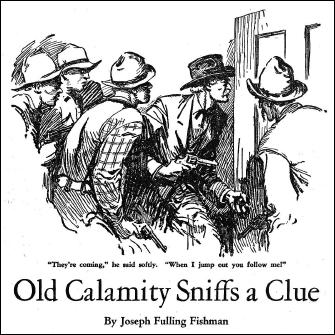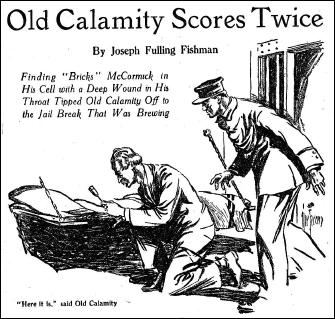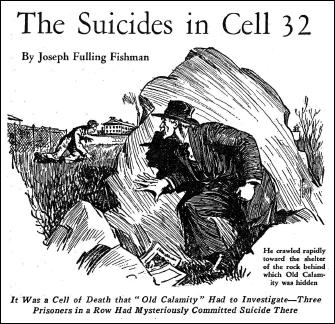Wed 12 Feb 2014
Characters from DFW #17: OLD CALAMITY — by Monte Herridge.
Posted by Steve under Bibliographies, Lists & Checklists , Characters , Columns , Pulp Fiction[4] Comments
DETECTIVE FICTION WEEKLY
by Monte Herridge
#17. OLD CALAMITY, by Joseph Fulling Fishman.
Joseph Fulling Fishman created the prison series (ran 1928-1939) for Detective Fiction Weekly about the jailer Old Calamity, making use of his knowledge of crime and prisons. In fact, Fishman wrote more nonfiction articles on these subjects from 1925-1942 for Detective Fiction Weekly than stories in the fiction series.
He also wrote articles for other magazines such as Reader’s Digest and The Saturday Evening Post, and books about crime and prisons. Fishman was a 1931 choice for a Guggenheim Fellowship. He was awarded a grant for being chosen. According to Wikipedia, the Fellowships “have been awarded annually since 1925 by the John Simon Guggenheim Memorial Foundation to those ‘who have demonstrated exceptional capacity for productive scholarship or exceptional creative ability in the arts.’ â€
The name Old Calamity is what the three thousand inmates of the state prison at Cosmopolis call him. The guards and other personnel call him Ole Dep Fletch out of his hearing. His real name is Deputy Warden Fletcher, and even though there is a warden who is a political appointee, Fletcher is really the one running the prison.
The wardens of the prison were all political appointees, but Fletcher was a professional jailer. The wardens were appointed by the state governor, but the governor on one occasion said: “You know, Fletcher. You’re really the one I should appoint warden, but of course there’s politics . . .†(Old Calamity’s Stick-up)
“Thirty years of combating the plots and counterplots and the intrigues and chicanery of thousands of inmates of every degree of criminality and cunning and viciousness . . . had sharpened the perceptions of the Deputy Warden.†(Old Calamity Starts a Fight)
This long experience gave Old Calamity an advantage when dealing with the many problems that he came across in his job. He knew just about every trick the convicts tried, and how to deal with them. He enjoys his work, and at one point turns down a job offer from a rich businessman with the comment “I’m afraid not, thank you,†Old Calamity replied. “I’m doing the kind of work I like and that’s worth more than money.†(Old Calamity Sniffs a Clue)

He usually went to work in the prison at seven in the morning, and had a regular routine except when emergencies or problems interrupted. His usual morning routine was “supervising the count, reading his mail, making assignments of new prisoners, and so on, . . .†(By a Nose)
He doesn’t let the routine of everyday work get himself in a rut where he overlooks things; he notices the smallest detail of what may turn out to be very important to him and the prison. Probably why he has lasted so long in his job.
The stories are basically all about Old Calamity, with very few appearances by a regular cast of characters. One regular is Croaker Engle, the “brusque old prison doctor.†His appearances in the stories are usually very short. Before him, a Doctor Cosgrove made a single appearance in the story “Fine Feathers.â€
The prison warden is mentioned in the stories, but plays very little part in the stories. An exception to this are the stories “Old Calamity Starts a Fight,†and “Between the Lines,†where part of the story takes place around the warden. The warden of the prison is replaced at one point in the series. The warden and Old Calamity both have homes right next to the prison grounds.
The stories usually involve murder in the prison by inmates murdering other inmates, for various motives. Prison breaks and conspiracies aimed at escaping prison are also elements in the stories. Fletcher has to break up the escapes, which sometimes are very cleverly planned.
In the story “Old Calamity Scores Twice,†he not only has to foil a planned escape, but solve a clever locked cell murder made to look like suicide. In “Between the Lines,†he literally has to read between the lines of a prisoner’s book reading material to discover a plot to escape using explosives.

The earliest story in the series, “By a Nose,†involves uncovering a murder by bomb and finding the culprit. His investigations of various kinds involve him acting more as a detail-oriented detective than as a deputy warden.
Another concern of prison authorities is the use of illegal drugs by the inmates. The story “Fine Feathers†relates the attempt of Old Calamity to stop the flow of drugs into the prison, and in a later story, “Old Calamity Starts a Fight,†the problem of drug usage is also the main theme. This is certainly based on situations in real prisons at the time. Morphine is the drug mentioned in these stories.
“Fine Feathers†relates some of the problems that drug usage by inmates causes – aggressiveness and fighting by prisoners, and other irrational behavior. One prisoner high on drugs even set his cell on fire.
One story showed Old Calamity on vacation, enjoying relaxing fishing. However, the local law enforcement find out he is there and enlist his aid in solving a series of inexplicable burglaries. (Old Calamity Sniffs a Clue)
This use of Old Calamity’s talents outside his own prison was not the only time this occurred. It appears that he was available for aid at other prisons having problems. In the story “The Suicides in Cell 32,†he travels to Milford State Prison to help investigate a series of murders made to look like suicides.

Warden Olmstead of the prison knew of his reputation and had requested his help. In less than twelve hours Old Calamity has solved the mystery and was on his way back to his own prison. He noted: “I guess that some of the birds up at my place will be sorry it didn’t take me several weeks. I’m afraid they won’t be any too glad to see me back in the morning.â€
In “Old Calamity Lays the Ghost,†he travels to another prison in Springdale in response to another request for help. Warden Armitage of the prison has a mystery for him to solve: twice men in their cells have been stabbed and nearly killed. In both instances knives were found in the cells, but no evidence was found as to how the men could have been stabbed inside of locked cells.
Old Calamity finds an ingenious method has been employed in the stabbings. It took him a few days to resolve this one, but he had developed the patience to wait for the right time. “He had often waited weeks and sometimes months for the development of a prison plot. He knew it was something that could not be hurried, . . .â€
The series is very good in its story telling and relation of the various mysteries Old Calamity is involved in. Altogether, Fishman’s descriptions of prison life and the psychological aspects of the stories seem to be very convincing, and made the stories more than mere sensationalistic prison stories such as other pulp writers wrote.
The “Old Calamity” series by Joseph Fulling Fishman:
By a Nose October 27, 1928
Fine Feathers February 2, 1929
The Yawn March 2, 1929
Old Calamity Stages an Act April 6, 1929
Old Calamity Lays the Ghost April 9, 1932
Old Calamity Holds the Wire July 23, 1932
Old Calamity Starts a Fight September 17, 1932
Old Calamity Scores Twice February 11, 1933
The Suicides in Cell Thirty-Two June 17, 1933
Between the Lines September 9, 1933
Old Calamity Sniffs a Clue April 7, 1934
Old Calamity Cleans Up May 19, 1934
Old Calamity’s Stick-up June 23, 1934
Old Calamity Stops a Leak June 5, 1937
Honor of Thieves March 18, 1939
Previously in this series:
1. SHAMUS MAGUIRE, by Stanley Day.
2. HAPPY McGONIGLE, by Paul Allenby.
3. ARTY BEELE, by Ruth & Alexander Wilson.
4. COLIN HAIG, by H. Bedford-Jones.
5. SECRET AGENT GEORGE DEVRITE, by Tom Curry.
6. BATTLE McKIM, by Edward Parrish Ware.
7. TUG NORTON by Edward Parrish Ware.
8. CANDID JONES by Richard Sale.
9. THE PATENT LEATHER KID, by Erle Stanley Gardner.
10. OSCAR VAN DUYVEN & PIERRE LEMASSE, by Robert Brennan.
11. INSPECTOR FRAYNE, by Harold de Polo.
12. INDIAN JOHN SEATTLE, by Charles Alexander.
13. HUGO OAKES, LAWYER-DETECTIVE, by J. Lane Linklater.
14. HANIGAN & IRVING, by Roger Torrey.
15. SENOR ARNAZ DE LOBO, by Erle Stanley Gardner.
16. DETECTIVE X. CROOK, by J. Jefferson Farjeon.
February 12th, 2014 at 12:38 pm
I’ve read some of these stories but it has been many years ago. Monte’s article points out that the stories are convincing and not the usual pulp prison stories. I’ll be pulling out some issues and reading them again.
February 12th, 2014 at 1:44 pm
I’m surprised that not only does the character not ring any bells with me, but I don’t even recognize the name of the author. My collection of DFW in the early 30s is rather spotty, but I didn’t think it was that spotty. Monte, thanks for widening my education!
February 12th, 2014 at 7:24 pm
At lunch I decided to read one of the Old Calamity stories. I read “Old Calamity Lays the Ghost” in the April 9, 1932 issue of DETECTIVE FICTION WEEKLY. It was a short 7 pages but I enjoyed it.
The issue itself is interesting. I used to put the price I paid for pulps and books inside on the first page and I see I paid $1.25 for this issue back in the 1970’s.
In addition to the Old Calamity series story there also were a couple of other series:
“The Bird in the Hand” by Gardner. A Lester Leith story which I read and enjoyed back in 1971. 25 page novelet and my note says, “Usual light hearted, fast Lester Leith caper”.
Also “More Than Satisfied” by Victor Maxwell, a Sgt. Riordan series story.
In addition there were several other stories including a serial installment by Fred MacIsaac. At 10 cents this was an amazing bargain. Even in today’s money 10 cents is no more than a couple dollars and you can’t produce a 7 by 10 inch, 144 page magazine for anywhere near that amount. It would cost somewhere over $10.00 nowadays and not have the distribution that they had back in 1932.
February 14th, 2014 at 7:19 pm
This is a good article!
I’ve really enjoyed the whole DFW series.
Usually I’ve never read any of the stories: I’m not a collector of pulps or anything else rare.
But one of the Old Calamity stories is reprinted in an anthology: “Old Calamity’s Stick-up”. It’s a nice story. It’s in “100 Dastardly Little Detective Stories” (1993), edited by Robert E. Weinberg, Stefan Dziemianowicz and Martin H. Greenberg.
Wish more of these Old Calamity stories were available to read.